Table of contents
- Buying advice: personal protective equipment for bikers This should be taken into account with motorcycle protective clothing
- Joints: neuralgic points
- Chest, back: covering the whole area
- Neck, neck: new school
- Gloves, boots: essential
- Conclusion

Image: Manufacturer
clothing
Personal protective equipment for motorcyclists – advice
Buying advice: personal protective equipment for bikers
This should be taken into account with motorcycle protective clothing
PSA – no, not a Dutch football club, not even a pesticide or anything like that. The three letters stand for: Personal protective equipment. The outfitters have to adhere to fixed standards, but motorcyclists often do not know what to look for when buying.
Thorsten Dentges
01/19/2012
Parents know this, and everyone else may still remember their childhood. When running and romping around, the brats usually get on their knees. The little ones initially wear bloody, purulent decorations on the affected areas, then mothers like to tune the corduroy trousers with patch leather hearts or teddy bear patches made of abrasion-resistant yarn. Functional, fashionable gimmicks like this are less common in driver’s equipment, but luckily you are much less likely to be blown on the nose in road traffic. This is usually hardly affected in an accident, but the knees and lower legs are. The risk of injury to this area of the body in a motorcycle accident is an impressive 40 percent. Because just like the raging little ones on the play street, as a big one on a toy motorcycle, you fall on your knees in many fall situations. Incidentally, reliable figures on the risk of injury come from accident research. Professor Dietmar Otte and his team from traffic accident research at the Medical University in Hanover have evaluated more than 1,600 motorcycle accidents since 1999. Valuable data, especially when it comes to how and where to improve the safety of motorcyclists.
And we are right in the middle of it: Personal protective equipment for motorcyclists, PPE for short. It should be clear that bikers don’t tie teddy bears to their knees, but what exactly should optimal PPE look like? Christoph Gatzweiler from the Motorbike Industry Association in Essen has his opinion on this and also refers to legal requirements that are set up at European level in the form of standards. The European standard EN 1621-1, which is currently being revised, applies to joint protectors. And that is also necessary, because this standard is almost 15 years old, and when it was drawn up, the focus was more on political trenches than medical facts, or more precisely: basic biomechanical research. As a compromise, limit values were agreed at the time, which, according to today’s opinion, do not offer sufficient protection against injury. Single impacts of up to 50 kilonewtons (kN) and an average value of 35 kN are sufficient to pass the type examination. According to studies, human bones break at four to five kilonewtons. In addition, the force-time curve has not been taken into account so far. To illustrate: A tired heavyweight boxer who only wrestles instead of punches is less dangerous than a fresh karate fighter who even beats stone walls with less force but higher striking speed. So there are huge differences between force and power and between protector and protector.
Buy complete article
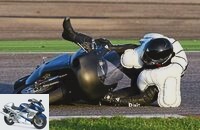
Buying advice: personal protective equipment for bikers
This should be taken into account with motorcycle protective clothing
8 pages) as PDF
€ 2.00
Buy now
The first joint protectors to be identified as such came from the Swedish manufacturer Halvarssons around 25 years ago – padded, pre-formed plastic shells for the knees. And also the Italian supplier Dainese took up the topic early on and is considered a pioneer. But only in the last ten years have the materials been significantly improved. Hard shells generally try to distribute the point of impact over the largest possible area and at the same time prevent sharp objects from penetrating. Great for example in the field if you fall on stick and stone. Protectors made of soft foam – this is not about simple mattress foam, but special foams made of polyurethane (PU) and other plastics – on the other hand, dampen the impact better and ideally only let the acting force through slowly (see also diagram on page 54). Good cushioning is good when you hit the asphalt flat, but after the impact comes the grinding phase. And that is not taken into account in any standardization. In the event of a fall, the injuries are very different, depending on whether the rider, assuming a corresponding fall zone, slides to a standstill (ideally only a few scratches and bruises) or whether he overturns with unwanted gymnastic figures and somersaults (breaks are more the rule than the exception). The amended EN 1621-1, which will soon come into force, lowers the mean residual force value to 20 instead of 35 kN. Not a revolution, especially since good joint protectors easily meet these requirements.

fact
Back protectors: An injury to the spinal cord with the prospect of a rest of life in a wheelchair justifies an increased need for protection.
The limit values are lower for back protectors (currently 9 kN for level 2
average, 12 kN for a single blow). Large area, great need for protection, this is probably the thinking of many motorcyclists. Admittedly, an injury to the spinal cord with the prospect of a rest of life in a wheelchair justifies an increased need for protection. The numbers of accident researchers, however, speak a different language. The spine is only affected in around eight percent of accidents, and the majority of paraplegia caused by accidents is caused by compression and torsion. Tragic injuries can hardly be completely avoided even with an excellent shock-absorbing back protector. Nevertheless, every motorcyclist is advised to have back or joint protection as completely as possible, because protectors serve as additional protection against abrasion if the outer material (leather or textile fabric) of the suit is worn through. If things go badly, abrasions can also result in stubborn germ infections.
A new standard, EN 1621-3 and EN 1621-4, has also recently applied to chest protectors and airbags. This is progress, because anything that helps motorcyclists prevent serious injuries is commendable. In the chest area in particular, they occur twice as often as on the spine. Injuries to vital organs such as the lungs should therefore be counteracted with all possible means. This also applies to neck protection systems for which no standard has yet been drawn up – unlike boots (EN 13634), gloves (EN 13594) and outerwear (EN 13595-1 to 4).
To avoid misunderstandings: For motorcyclists, standards do not mean that they are forced into a suit of armor, but the specifications apply to the manufacturers, whose (marketing) promises one would otherwise have to completely rely on. A healthy skepticism is called for if the equivalent value cannot be clearly measured.
Joints: neuralgic points
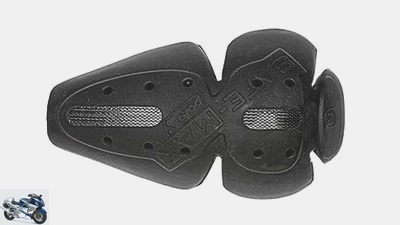
MPS photo studio
MOTORCYCLE test winner: Safemax PREMIUM: joint protectors.
It was only since the EN 1621-1 standard, which came into force for the first time in 1997, that most of the garment manufacturers seriously concerned themselves with improving joint protection. Since then, the fit and cushioning properties have been continuously optimized through new materials. Nowadays the protective effect is usually far above the required standard. This is a good thing, because joints are the most frequently affected fall zones, and with a residual force of up to 50 kN allowed for the type test for a single blow, bones would probably splinter quite nastily. The test winners and the best products (now mostly soft foam protectors), however, only let around 10 kN through at the knees on impact, which significantly reduces the risk of breakage. One major difficulty, however, remains: many clothing positions the exemplary protectors in jackets and trousers rather negligently. In the event of a fall, especially with comfortably cut textile clothing, the protectors slip and the joints are exposed again, at great risk of injury. With tight-fitting leather combinations, the foam parts or hard shells usually sit more firmly and therefore protect better. In general, protectors on shoulders, elbows, hips and knees should be a must. However, MOTORRAD recommends a detailed fitting before buying – please also in the riding position on the machine!
MOTORCYCLE purchase tip: BMW NP
The soft foam surrounds the joints, especially the knees, perfectly and offers good security. Price for a complete set: 84 euros.
MOTORCYCLE test winner: Safemax PREMIUM
Indeed “premium” – top marks in the shock absorption test and in the comfort rating. With 70 euros for a complete set, a good investment in your own safety.
Chest, back: covering the whole area
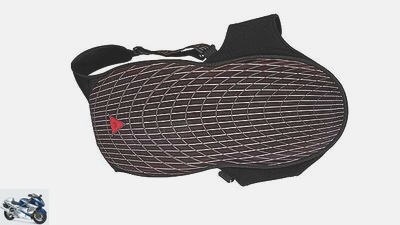
MPS photo studio
MOTORCYCLE purchase tip: Dainese N-Frame BACK 3.
Motorcyclists should by no means do without this part of the PPE, because injuries to the chest and back caused by falls are often drastic. Any protection against such dire consequences of an accident is therefore worthwhile if active safety is not impaired. The numerous MOTORCYCLE tests and experiences show that modern, well-made back protectors can hardly be felt while driving. Incidentally, this applies equally to hard-shell and soft foam protectors. The additional weight to the jacket is bearable for the top products (see right), the fit is good to very good. Slide-in protectors are more comfortable to use, so always wear them to men or women. Strap-on protectors are closer to the body and closer to the body and are therefore usually safer. The respective advantages speak for both groups, excellent shock absorption values can also be found in both (up to less than 5 kN residual force). Another important argument for wearing back protectors is the protection of the shoulder blades, which are particularly at risk of breaking, provided that the protector also covers these areas well. When trying it on, make sure that it is the right shape and size! Chest protectors have so far rarely been offered, but they have a great raison d’être, as they can prevent any internal injuries.
Alpinestars Bionic Chest Pad
The Italians have tried a lot in racing and now want to convince touring riders of the chest area protection with new protectors (19.95 euros).
MOTORRAD test winner: Hiprotec Backshock
Effective: The slide-in protector made of several layers of soft foam impresses with only six kilonewtons of residual force in the standardized shock absorption test. Price: 19.95 euros.
MOTORCYCLE purchase tip: Supershield SC-1/15
18.95 euros, but there is a great fit, good ventilation and comparatively little weight. The viscoelastic foam protector that can be pushed into the back pocket of the jacket does its job well.
MOTORCYCLE purchase tip: Dainese N-Frame BACK 3
Amazingly lighter (only around 600 grams), more comfortable and inexpensive (89 euros) hard-shell strap-on protector that can be attached well and close to the body regardless of the jacket cut.
MOTORCYCLE test winner: Vanucci Protector vest
Excellent coverage from the neck down to the rump, very good shock absorption (5.4 kN residual force). The vest weighs one kilo and costs 139.95 euros.
Neck, neck: new school
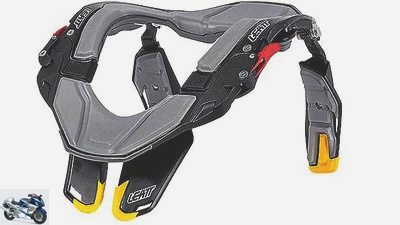
MPS photo studio
Leatt STX Road.
Broken neck – a horror scenario that worries not only worried mothers of motorcyclists. Indeed, injuries to the cervical spine (cervical spine) often have tragic consequences (paraplegia), which makes sense that you want to protect yourself from them. However, developers and manufacturers have only dared to tackle this sensitive topic in the last few years. The South African orthopedist Dr. Chris Leatt witnessed a fatal motor sport accident in 2001 and developed a protective system for the cervical spine area for the first time together with BMW and KTM. The principle: A special ruff (“brace”) is primarily intended to prevent fatal flexions (overstretching) and compression. The problem: A system like this can only function if it is optimally applied, and that requires expert fine-tuning. In off-road circles – braces are now established among enduro riders and motocross riders – it has already been criticized that the braces would have led to broken collarbones, although the course of the accident normally did not suggest such consequences. Accident researchers also question the benefits and effects of braces for road drivers. The cervical spine is affected in well below ten percent of all accidents, and there is a lack of reliable, empirical evidence as to whether braces actually reduce the risk of injury. In the case of off-road accidents, especially when falling in soft sand, however, it is advisable to also close this gap in the PPE, the same accident researchers agree on this. The systems tested by MOTORRAD (see right) fit at least well and hardly affect active safety. So buy? If there is money left for it, yes.
Leatt STX Road
The only system designed only for road drivers comes from pioneer Leatt. Costs 399 euros.
Moveo Dynamic
The biggest competitor comes from Spain, is easier to use and cheaper (289.90 euros).
Gloves, boots: essential
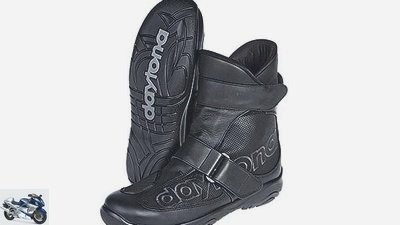
MPS photo studio
MOTORRAD test winner: Daytona Journey XCR.
Often it is the small, inconspicuous things that play a major role. In the case of PPE, these are gloves and boots. The helmet is legally required protection, but there is the possibility of misunderstood freedom on the hands and feet. In the event of a fall, the probability of landing on the ends of the extremities is very high, and then barehanded or with only light sneakers on the feet, nasty injuries are programmed. Even if the consequences are rarely fatal, in extreme cases they can have a major impact on the further life of the accident victim (amputations). Every motorcyclist should therefore impose their own glove and boot obligation. The pieces of equipment are affordable, solid gloves with double layers of material in the fall zones are available from around 30 euros (full leather is usually safer than a textile mix), decent boots from around 70 euros. Good anti-slip protection is essential for gloves; when trying on gloves, it is advisable to pull firmly on the glove fingers with the wrist (Velcro) strap closed. Good gloves won’t slip off your wrist, even if you exert a lot of force, while poorly cut, overly elastic gloves with a slack latch can be pulled off easily – and should then be put back on the shelf. Due to their design, boots sit tightly over the ankles (be careful with leisure-oriented short boots that offer little fixation) and protect against overstretching and torn ligaments even in the event of smaller falls or even falls. They offer good security if the materials (leather, plastic, textile fabric) are abrasion-resistant. Boots with a high shaft and integrated protectors on the shins and ankles offer the best protection.
MOTORCYCLE test winner: hero Satu First Class
Grip and yet adjusted to (almost) all weather conditions. For 79.95 euros you get a very reliable travel partner.
MOTORCYCLE purchase tip: Probiker Artic 3
When driving below ten degrees, warm winter gloves should be on the hands. Great: the inexpensive Probiker (49.95 euros) are safe to wipe off.
MOTORCYCLE test winner: Daytona Journey XCR
Offer proper security, are significantly lighter and easier to wear than normal motorcycle boots. For city trips and short tours (174.95 euros).
Arleness pro shift
The sister magazine PS named the boot (299 euros) the test winner. First choice for sports drivers with high safety requirements.
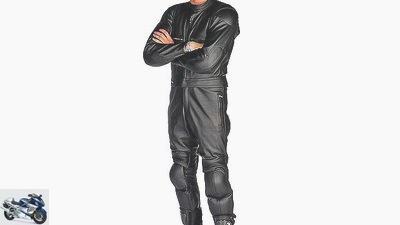
MPS photo studio
Swabian leather Classic Pro Sport.
They still exist, the categorical refusers of designated motorcycle clothing, who prefer to cruise around in jeans and a shirt or a cowl according to the motto “I don’t intend to fall”, but they are becoming fewer and fewer. Complete suits with reasonable equipment in a fashionable variety (from rock to pop to technoid) are available from around 300 euros. However, one should not expect the best protective properties in the lower price ranges. In particular, tear resistance (safety seams present?) And abrasion resistance in textile motorcycle clothing are often insufficient in the event of a fall. When sliding on the asphalt, light fabrics sometimes rub on after just one second (good leather only takes around seven seconds if you fall from the speed of a country road) and are not particularly heat-resistant. Friction on the road surface causes temperatures of up to 200 degrees. Polyamide or polyester fibers then fuse and burn into the skin. This does not happen with leather, but since even low-budget textile clothes offer better weather protection compared to leather and normal street clothing and thus contribute to active safety, they are still recommended. Supported by more heat-resistant aramid fibers (Kevlar) and more abrasion-resistant fabrics (e.g. Dynax, Cordura 1000, dynatec), the accident protection increases significantly, but the price also increases by several 100 euros. Protectors in jackets and trousers have a major influence on the protective effect (see also boxes on page 55). But only if available and sitting in the right place. Here, too, leather suits have the edge because they tend to fit closer to the body, because what is tight cannot slip out of place easily. The textile tailors have largely neglected to tie integrated joint protectors to the driver by means of suitable and in practice easy to use fixation options in such a way that full protection is guaranteed. So when it comes to safety, the leather wins points – the better second skin.
MOTORCYCLE purchase tip: Alpinestars Durban
Well-balanced, comfortable and weatherproof high-end textile suit with a snug fit and a good, body-hugging cut for 999.90 euros. Top for longer trips.
MOTORRAD test winner: Schwabenleder Classic Pro Sport
Sporty, tight cut, very functional, yet timelessly classic look. An acquisition for life. For this and for the best security (robust, 1.5 millimeter thick cowhide) around 1300 euros are well invested.
Conclusion
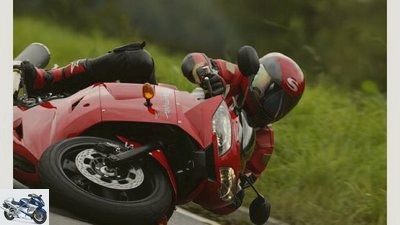
Jahn
In the event of a fall, PPE helps prevent extremely serious injuries.
It is wrong to believe that PPE will save your skin in any situation. However, top protectors, good gloves, boots and outerwear undoubtedly help to alleviate serious injuries. The PPE does a good job in the case of smaller, undramatic falls which, without protective equipment, often lead to very annoying injuries (breaks, torn ligaments, etc.). That is reason enough to really wear them, because buying alone is not enough as protection. However, there is one point that no standardization can cover: active safety. Every driver and every driving day is different. Unfortunately, a lot doesn’t always help a lot, motorcyclists can also equip themselves excessively, so that personal freedom of movement and air conditioning are negatively affected, which in certain circumstances can lead to an accident. So how do you do it right now? Trying instead of studying – good readings are not everything, the PPE has to fit like a glove. And don’t be stingy when buying, good equipment (see buying tips and test winners) has its price. We also like to spend money on the most beautiful, but unfortunately not entirely harmless, toys in the world, motorcycles. Maintaining your own health should also be worth every penny.
Related articles
-
Protective equipment for motorcyclists
manufacturer clothing Protective equipment for motorcyclists Protective equipment for motorcyclists Protectors, airbags, scarves Motorcycles ride well…
-
Buying advice for alternative motorcycle rider equipment
mps studio 41 pictures Dentges 1/41 The gear lever often messes up street shoes. For 14.90 euros, Louis offers a “Shoe Protector”. Dentges 2/41 BW combat…
-
Buying advice for airbag systems for motorcyclists
Alpinestars 18th pictures Photos: alpinestars 1/18 More than just (hot) air: airbags can prevent greater damage to life and limb in the event of an…
-
Product test photo equipment for motorcyclists
Dentges accesories Product test photo equipment for motorcyclists Photographic equipment for motorcyclists Comparison test: digital compact and reflex…
-
Artist counselor Used purchase Second-hand advice Second-hand advice on supermotos and funduros Young and with a few kilometers Out of the way! Even the…
-
Second hand advice Yamaha BT 1100 Bulldog
Yamaha counselor Used purchase Second hand advice Yamaha BT 1100 Bulldog Second hand advice Yamaha BT 1100 Bulldog Sociable buddy guy The Bulldog was…
-
fact counselor Used purchase Used advice muscle bikes BMW K 1200 R, HD V-Rod, Triumph Rocket III, Yamaha MT-01 Used advice muscle bikes “Waste your life…
-
Second-hand advice: ABS bikes up to 4000 euros
Jahn counselor Used purchase Second-hand advice: ABS bikes up to 4000 euros Second-hand advice: ABS bikes up to 4000 euros Cheap ABS bikes Most want it,…
-
Advice on used Big Bikes for 2500 euros
counselor Used purchase Second-hand advice on Big Bikes for 2500 euros Second-hand advice on Big Bikes for 2500 euros Here is playing the music Mighty…
-
Second-hand advice on XXL bikes
Bilski 19th pictures Honda 1/19 Honda Goldwing. manufacturer 2/19 Honda Varadero 125. manufacturer 3/19 MZ 125 SM. Suzuki 4/19 Suzuki Burgman 650….